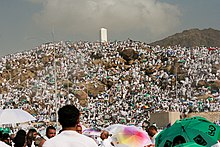ʿArafāt
ʿArafāt ( Arabic عرفات) is a plain around 20 km southeast of Mecca , where the central ritual of the Islamic Hajj pilgrimage takes place. The day reserved for this ritual, the 9th Dhu l-hijjah , will also be ʿArafa day (يوم عرفة) called. Without attending the lingering ceremony ( wuqūf ) in ʿArafāt , the Hajj has no validity.
The ʿArafāt plain has an area of approximately 6.5 km in an east-west direction and 11 to 13 km in a north-south direction. On the north-eastern edge is the 61 m high Jabal ar-Rahma ("Mountain of Mercy"). It is also called ʿArafāt Mountain ( ǧabal ʿArafāt ). Tents are pitched for ʿArafa day to provide protection from the sun. During this day all pilgrims are in this plane.
Description of the ritual that takes place in ʿArafāt
On the morning of the 9th Dhū l-Hijjah, the pilgrims in their Ihram clothing go to the ʿArafāt Plain and gather there. As soon as the sun has passed its highest point, the central event of Hajj begins. The pilgrims perform the noon and afternoon prayers together and then stay there until sunset. This lingering ceremony is called Wuqūf , meaning “standing before God”. The area in which the Wuqūf is legally permissible is marked by border marks.
At the beginning of the Wuqūf, a well-known Islamic scholar holds a two-part Chutba , commemorating the Prophet's farewell sermon , which he gave at this point shortly before his death. During this ceremony, the pilgrims recite Quranic verses, say blessings on the Prophet, and pray supplications and the Talbiya . Shortly after sunset, the so-called Ifāda begins , the "outflow". The pilgrims rush out of the plain towards the Muzdalifa valley , which is halfway between ʿArafāt and Mecca. In Muzdalifa the pilgrims finish the Ifāda and perform evening and night prayers together at the end of the day. The gathering of two prayers at noon and two after sunset is a specialty of ʿArafa Day. The following passage in Sura 2 : 198 relates to the Ifāda and the subsequent prayer in Muzdalifa : "If you have performed the Ifāda from ʿArafāt, then remember God at the holy place of worship!"
Some Muslims also fast on ʿArafa Day. It is controversial whether this fasting is prescribed as a sunnah or a voluntary act; because there is no corresponding instruction in the Koran.
history

The Wuqūf on ʿArafa Day has pre-Islamic origins. In ancient Arabia, it formed the final ritual of the annual markets of ʿUkāz , Dhū l-Madschāz and Majanna, which took place in the holy months near ʿArafāt. After the Muslims took Mecca, the ritual was Islamized. During the so-called farewell pilgrimage shortly before his death in 632, Mohammed gave a speech in the ʿArafāt plain and also laid down the rules for the ritual.
According to Islamic tradition, sura 5 , verse 3 was revealed at this point and recited by Mohammed: “Today I have completed your religion for you (so that nothing is missing from it) and my grace for you, and I am satisfied that you have Islam as a religion. "
The boundaries of the area of ʿArafāt were fixed geographically in Fiqh in the 8th century . In the 12th century, the Zengid vizier Jamāl ad-Dīn al-Isfahānī (d. 1164) built a mosque on the Jabal ar-Rahma and put on a staircase that led up to it. He also built an underground aqueduct that supplied the ʿArafāt Plain with water during the days of Hajj. This line, called ʿAin ʿArafāt , was repeatedly repaired in the following centuries and extended to Mecca in the 1560s.
literature
- AJ Wensinck, HAR Gibb: Art. ʿArafa in The Encyclopaedia of Islam. New Edition . Vol. IS 604.
- Patricia Crone : Meccan Trade and the Rise of Islam . Princeton, New Jersey 1987. pp. 170-76.
Individual evidence
- ↑ P. Lory: "al-Wuḳūf" in The Encyclopaedia of Islam. New Edition Vol. XI, pp. 220b-221b. Here p. 221a.
- ↑ Additional text evidence as a scanned page (in The Encyclopaedia of Islam. New Edition Vol. XI, pp. 220b-221b. - p. 221a) Archive link ( Memento from September 21, 2016 in the Internet Archive )
- ↑ See e.g. B. an-Nuwairi : Nihāyat al-arab fī funūn al-adab . Ed. Saʿīd ʿĀšūr. Cairo 1985. Vol. XXVII, p. 176.
- ^ Al-mausūʿa al-fiqhiyya Kuwait 1994 (1st edition). Volume 30, pp. 60-61.
- ^ W. Montgomery Watt; Alford T. Welch: Islam I. Mohammed and the early days, Islamic law, religious life. Stuttgart 1980. pp. 336f.
- ^ The Encyclopaedia of Islam. New Edition. Brill, suffering. Vol. 9, pp. 94f.
- ↑ Julius Wellhausen: Remains of Arab paganism. 2nd Edition. Berlin and Leipzig 1927, pp. 81–82; The Encyclopaedia of Islam . New Edition. Brill, Leiden, Vol. 11, p. 220 (wuqūf); Robertson Smith: Lectures on the Religion of the Semites. 3. Edition. London 1927, pp. 340-341
- ↑ See Crone 170.
- ^ Translation: Rudi Paret
- ↑ Cf. an-Nuwairī : Nihāyat al-arab fī funūn al-adab . Ed. Naǧīb Muṣṭafā and Ḥikmat Kašlī Fauwāz. Cairo 2004. Vol. XXVII, p. 125. Digitized
Coordinates: 21 ° 21 ' N , 39 ° 59' E


